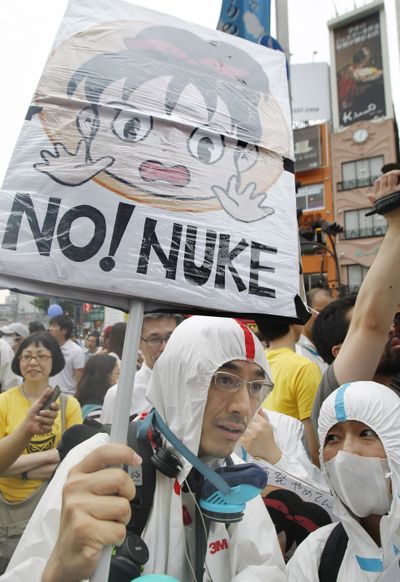Nuclear power draws protests across Japan
It’s been 3 months since twin disasters

TOKYO – Protesters held mass demonstrations against nuclear power across Japan on Saturday, the three-month anniversary of the powerful earthquake and tsunami that killed more than 23,000 and triggered one of the world’s worst nuclear disasters.
Streets in parts of Tokyo were jammed with thousands of chanting protesters, paralyzing sections of the city. Some marchers called for the country’s nuclear plants to be shut down immediately and for stricter radiation tests by the government.
The magnitude-9 earthquake that hit March 11 off Japan’s northeast coast caused a massive tsunami that devastated the coastline. The disasters knocked out power and cooling systems at the Fukushima Dai-ichi nuclear power plant, about 140 miles northeast of Tokyo, setting off explosions, fires and large radiation leaks at the facility.
Government reports released earlier in the week said the damage and leakage were worse than previously thought, with some of the nuclear fuel in three reactors likely having melted through the main cores and inner containment vessels. They said the radiation that leaked into the air amounted to about one-sixth of the Chernobyl nuclear disaster in 1986 – double previous estimates.
The disasters have renewed a national debate on nuclear power in Japan, which has few natural resources. Japan relied on nuclear energy for 30 percent of its electricity before the disasters and planned to raise that to 50 percent by 2030, but the government has announced it will abandon that target and promote renewable energy instead.
“Since the earthquake, I’ve realized that nuclear power is just too dangerous for use,” said Takeshi Terada, 32, a shipping worker who marched with 10 friends in Tokyo.
Some nuclear plants across the country remain shut in the wake of the disaster, leading to fears Tokyo and other areas may not have enough electricity for the peak summer months. Residents of the capital are reducing their use of lights and air conditioning, and some companies are moving crucial operations to parts of Japan with more stable power supplies.
At the Fukushima plant, hundreds of workers are still struggling to bring the crippled reactors to a “cold shutdown” by early next year and end the crisis. Radiation fears have forced more than 80,000 people to evacuate from their homes.
Many more people have had to leave their homes along the northeast coast because of tsunami damage. Three months after the disasters, 90,000 are still living in temporary shelters such as school gyms and community centers.
Along the tsunami-ravaged coast, residents bowed their heads in a moment of silence at 2:46 p.m., when the earthquake struck.
Embattled Japanese Prime Minister Naoto Kan visited Kamaishi, a hard-hit coastal city. Kan has been under fire for his handling of the disasters and the country’s recovery plans, surviving a no-confidence vote earlier this month by promising to step down once the recovery takes hold.
Speculation about when he will quit has been rampant, with his party and the main opposition hinting at a coalition to speed the recovery. But Kan’s visit Saturday was seen by some as a suggestion he will attempt to prolong his tenure.
“It is not just a matter of listening to what people say at the destroyed areas. I want to incorporate what I hear into government measures,” he said.